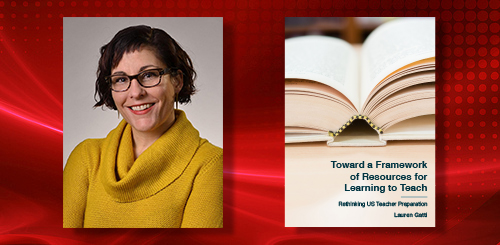
New book by Gatti explores teacher preparation pathways
09 Feb 2016 By Brad Stauffer
Traditional teacher preparation programs are receiving intensifying criticism for not doing enough to prepare teachers who can improve student achievement and close the achievement gap. As a result, policymakers are placing increasing faith in alternative routes to prepare quality teachers. Exploring how teachers in traditional and alternative pathways (such as Teach for America or teacher residency programs) learn to teach is the topic of a new book by Lauren Gatti, assistant professor in the Department of Teaching, Learning and Teacher Education in the College of Education and Human Sciences.
“Toward a Framework of Resources for Learning to Teach: Rethinking U.S. Teacher Preparation,” from Palgraves McMillan, examines the experiences of nine novice English teachers in a Midwest urban school environment. Some had come through a traditional university teacher preparation program and others participated in an urban teacher residency program, a fast-growing form of preparation modeled after the medical residency.
“This is a particularly intense moment for teacher preparation,” says Gatti. “One of the major issues in the field at this point is the traditional university route is pitted against alternative routes. In my research I tried to get beyond those paralyzing debates about which is better. It’s no exaggeration to say there's really kind of a war on university teacher preparation.”
Rather than trying to assess which pathway for teacher preparation was best, Gatti’s research and her book focused on how the resources these new teachers were accessing shaped their learning to teach process. In her study, Gatti identified five resources that she felt had the greatest impact on learning to teach in these very high need urban settings: programmatic resources (i.e., university coursework, length and location of clinical placements); disciplinary resources (i.e., disciplinary knowledge, coursework related to content, the “to what end?” of teaching a particular discipline); experiential resources (i.e., experiences working with youth, service experiences, religious involvement); dispositional resources (i.e., humor, flexibility, organization, faith); and relational resources (i.e., relationships to students, connections to school and the school community, students’ families).
“I don’t want to rank them, but relational resources ended up being an exceptionally powerful factor,” said Gatti. “You can't teach kids who don't trust you, and you can’t teach kids who you don't know. The teachers who were really able to make headway in their learning to teach, and their relationships with students, and their efficacy in the classroom, were teachers who found ways to develop relationships with their students.”
While Gatti says this is not an “earth shattering revelation,” it was stunning to her that preservice teachers—in either preparation program—did not get adequate training for working in an environment with predominantly minority children living at or below the poverty line.
“Race and class weren't really addressed,” she said, “especially in the residency program—which I find stunning, given that people were going into schools that had almost entirely poor student populations most of whom were black and brown students.”
Gatti determined that teacher preparation programs must “attend more carefully to the role of aims—the to what ends” of the strategies and concepts that teacher candidates are taught. “Teaching math to what end? Teaching English to what end? Teacher preparation to what end?” says Gatti. “I argue that centrally this really, really needs to be foregrounded within any teacher preparation pathway—in a course-related way—in the methods and the teacher supervision capacity.”
Gatti says a second major tenet of her book is something she calls “deep focus,” a term borrowed from cinematography and best known for Orson Welles’ use of it in “Citizen Kane.” Deep focus allows for the background and foreground images to be captured with equal clarity and precision.
“In teacher education, we have to attend with equal clarity and focus to what's happening in the policy context and what’s happening in classrooms,” said Gatti. “One major argument is that in any form of teacher preparation, we need to orient novice teachers to the policy context which they’re entering. That means they ought to be aware of these larger debates around what makes an effective teacher and how to evaluate teachers. These are debates they should be intimately familiar with and actively engaged with. The idea isn’t to churn out people who can raise test scores. The idea is to prepare teachers who can really cultivate the talent and experiences of the students they’re charged with teaching.”
Gatti will present a book talk (together with her colleague Theresa Catalano who will also talk about her new book) on “Toward a Framework of Resources for Learning to Teach: Rethinking U.S. Teacher Preparation” at 6 p.m., Feb. 26 in the Nebraska Union. Her book is in production and should be available for purchase in the spring. For more information, visit http://go.unl.edu/dzss.
College of Education and Human Sciences
Teaching, Learning & Teacher Education